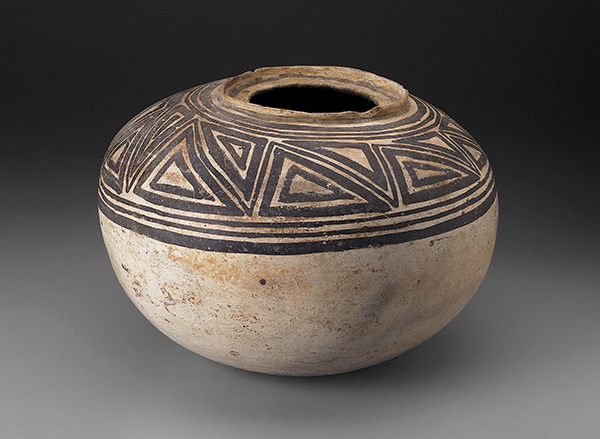Native American Heritage Month: Casas Grandes
Archeologists now believe that the earliest human settlements in the Americas occurred somewhere between 28,000 and 17,000 BCE, after migration across the Bering Strait land bridge, which disappeared under higher sea levels after the last ice age ended. Mass occupation of the Americas began around 14,000 BCE when ice sheets began to leave “trails” from Alaska down to Chile. This explains why we have seen viable cultures existing in the Americas since almost 4000 BCE, many in Central and South America.
 |
| Casas Grandes (Northern Mexico, ca. 700s–1450 CE), Jar, 1350–1450. Earthenware with slip paint, 7 3/16" x 9 15/16" (18.3 x 25.2 cm). © 2021 Museum of Fine Arts, Boston. (MFAB-479) |
The principle ancient cultures of the Southwest were the Hohokam of southern Arizona, the Mogollon/Mimbres of southwestern New Mexico, the Anasazi of the Four Corners region, and the Casas Grandes of northern Mexico and southern New Mexico, Arizona, and southwestern Texas. All were farming cultures that grew corn, beans, and squash. They were urban dwellers as well, living in communities of several hundred to several thousand. Their trade network was vast, ranging from central Mexico in the south, California and Baja California in the west, and the Great Plains in the north and east.
Origins of the Casas Grandes culture are obscure, although one theory is that it was a language group that migrated from the Baja California region on the Pacific Ocean. This is based on the numerous artifacts with shapes based on the conch-shell form. Of the major cultures of northern Mexico and the southern U.S., the Casas Grandes was the closest culturally to Mesoamerican societies because of ballcourts, ceremonial platform mounds, and ritual activities that are characteristic of Central America. However, they share aspects of communal housing such as five- and six-story apartment buildings, kiva-like pit houses, and ceramic styles with Puebloan cultures of the American Southwest.
Casas Grandes, a culture that built settlements as early as 700 CE, evolved into a major regional culture between 1150 CE and 1250 CE along the Rio Casas Grandes in northern Mexico. The main city of Paquimé was a trading center between Mesoamerica and Pueblo cultures. Many luxury goods from jewelry to ceramics made their way into Arizona and New Mexico from Central America. Casas Grandes pottery itself was similar to that of the Mogollon culture. Like many of the Pueblo cultures, Casas Grandes sites were abandoned during the 1400s, perhaps because of the change in growing seasons caused by a major drought two centuries before.
More First Nations art in Davis Programs: Explorations in Art 2E Grade 2: 5.7; Explorations in Art 2E Grade 3: 6.7; Explorations in Art 2E Grade 4: Unit 5 Intro; Explorations in Art 2E Grade 5: 2.5; Explorations in Art 2E Grade 6: 2.8, 3.8, 4.4, Unit 5 p. 151; A Community Connection 2E: 1.4; A Global Experience 2E: 2.5; Beautiful Stuff from Nature: Section 3 p. 48; Experience Clay 2E: Chapter 2 p. 32, Chapter 5 pp. 147 and 180; Exploring Visual Design 4E: Chapter 11 p. 211


Comments